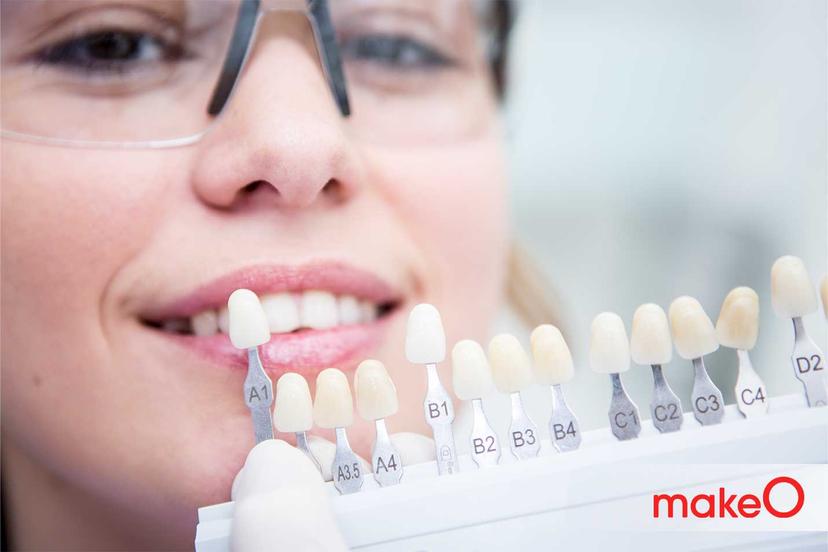MakeO blog
Dental plaque is a sticky film that deposits on your teeth which can lead to cavities and gum disease. Brushing helps to remove dental plaque, but it often misses the tiny teeth gaps where this plaque can build up. Dental floss is useful in such situations as it can remove up to 80% of plaque.
Modern floss is originally made from nylon or plastic and can be flavoured for convenience. Flossing teeth effectively cleans hard-to-reach spots that brushing misses, making it key for maintaining optimal oral hygiene and preventing teeth and gum issues. But despite its benefits, only 10%–30% of adults floss regularly. 1,2 This article will discuss in detail about the benefits of flossing, its technique and tools. Understanding these can encourage you to incorporate this simple practice into your daily routine, even if you wear teeth alignment appliances like clear aligners.
Flossing Techniques and Tools
Flossing helps to maintain good oral health by clearing out the plaque and food particles that brushing alone cannot clean. It can help to clean between the teeth and below the gumline, keep gums healthy and reduce bad breath. Flossing at least once a day for 2 to 3 minutes can give better results.
Flossing Methods
There are different methods that can be used to effectively floss your teeth:
- Spool Method (Finger-Wrap Method)
- Cut around 18 to 20 inches of dental floss and wrap up the ends around your middle fingers.
- Use your index fingers and thumbs to manoeuvre the floss between your teeth with an up-and-down motion. Shape the floss into a ‘C’ around each tooth and gently move it below the gumline.
- Loop Method (Circle Method)
- Cut 18 inches of floss and tie it into a circle.
- Put all your fingers into the loop, except your thumbs.
- Guide the floss with your index fingers between your lower teeth and use your thumbs for flossing the upper teeth.
- Bend the floss around each tooth in a ‘C’ shape and move it below the gumline.3
Types of Flossing Tools
There are different flossing tools used to cater for various oral care needs.1,3,4,5 They are:
Waxed and Unwaxed Floss: Waxed flosses are ideal for tight spaces while unwaxed ones are preferred for normal gaps.
Natural and Biodegradable: They are made from materials like bamboo, silk, or cornstarch. These are eco-friendly and can break down naturally. Silk floss can be less ethical, but bamboo and cornstarch are sustainable choices.
Thread and Tape: Thread floss is thin and suited for tight spaces; tape floss is wider and gentler for larger gaps.
Flavoured and Unflavoured: Flavoured floss, like mint, makes flossing more pleasant and can leave a clean taste, while unflavoured floss is plain but works the same. Some flosses are coated with fluoride to help prevent tooth decay.
PTFE (Polytetrafluoroethylene) Floss: This floss material is smooth and durable, resists shredding but can be pricier.
UHMWPE Floss: Made from strong material and resistant to shredding, suitable for tight spaces but may be less comfortable.
Superfloss®: Effective for braces and dental appliances, combining a spongy section for large gaps, a floss section for plaque removal, and a stiffened end for insertion.
Water flossers use pulsating water to clean between teeth and below the gumline, effectively reducing plaque and offering an easy alternative to traditional flossing.
Disposable floss holders simplify the flossing process and help reach difficult spots.
By incorporating these techniques and tools, you can enhance your flossing routine and achieve better oral health.
Flossing with Aligners
Aligners are comfortable and discreet but can trap plaque and reduce saliva’s natural cleaning ability, increasing the risk of dental issues. Even with aligners, you need to floss regularly to maintain oral health. Flossing with aligners helps remove bacteria and food particles from difficult to reach areas, thereby aiding in prevention of tooth decay and gum inflammation.
For flossing effectively with aligners:
What You Need:
- Interdental toothbrushes or floss thread
- Water flosser for teeth
- Toothpaste or fluoride rinse
Flossing frequency: Floss at least once a day. If you have specific oral health needs, you might need to floss more frequently, such as in the morning and evening.
How to floss your teeth with aligners:
To floss with aligners, first remove them, then clean between your teeth with an interdental toothbrush or water flosser. Rinse your aligners before you put them back. Ensure you wear your aligners for the recommended hours every day.
What Happens If You Don't Floss When Having Aligners
During aligner therapy, the microbial environment in the mouth can be altered, which can foster bacterial growth and plaque buildup on teeth. Food entrapment may also occur under the aligners, fostering plaque buildup and dental issues. These can affect your overall oral health and cause teeth and gum problems.
Neglecting flossing while using aligners can cause plaque deposition between the teeth, which can lead to several problems:
- White Spots on Teeth: If you don’t floss regularly, plaque trapped on your teeth can cause white spots (demineralization) on teeth, which can ultimately lead to cavities.
- Gum Issues: Plaque and bacteria buildup in between the teeth can lead to gum problems like bleeding from gums, inflammation and recession.
- Bad breath: The gasses released by bacteria in plaque can lead to a foul odor from the mouth.
Long-standing plaque can convert into tartar and lead to drifting or loosening of teeth.
Flossing is thus crucial as it helps in removing the plaque and preventing these problems, so your teeth stay clean and healthy even with aligners.
Conclusion
Flossing helps to keep your gums and teeth healthy, especially if you are using aligners or invisible braces for teens and adults. It helps to remove plaque from between your teeth, reduces gum problems, and prevents issues like white spots. Whether you use traditional floss or a water flosser, regular flossing is very useful in maintaining good oral health and ensuring your aligners work effectively.
Related articles

Types of Braces: Removable vs Fixed Braces, Which is Right For You?

This Diwali, Smile Bright With makeO Teeth Whitening Kit

Dr. Pravin Shetty: Pioneer in Lingual Orthodontics & Innovative Smile Solutions
How do I Know I’m the Right Candidate for makeO toothsi Teeth Aligners?

